
Challenge 2500 | 11. Vlissingen
Tournament play continues! Reviewing my tournament result in Vlissingen; one more step forward on my quest of reaching 2500.Intro
Greetings!
After several months of no competitive chess (my last actual tournament (except for one weekend in Sicily playing the Italian league) was back in late March), a new stretch of tournament participations has begun.
Over the past week, I competed in Vlissingen, a Dutch coastal city in the south of the country, not too far from the border to Belgium. The tournament was a relatively strong open with several strong GMs participating.
Here's the link: https://www.hztoernooi.nl/index.php/en/
First the facts, as always: 6.5/9 (5 wins, 3 draws, 1 loss), a rating performance of 2524, a rating change of +9.
Happy with the result as such, though more was possible.
The games
Let's review the tournament round by round. As last time, I'll show one particularly interesting or relevant moment of each game.
(1)
In the first round, I was paired with the black pieces against Krien (1806). I got a comfortable position out of the opening, but my opponent held things together pretty well for quite a while.
In the following position, it might look at first glance as if White is just about to equalise.
How can Black to move secure a pretty much winning advantage though?

36. ...Bxe3 wins an important pawn. It might look like White will get decent drawing chances in a potential rook endgame, but after 37.Re1 d4 38.Bxe3 dxe3 39.Qxe4 Rxe4 40.Kf3 Rae8 41.Re2 Rb4! it becomes apparent that White has more problems than just being down a pawn, namely all those weak pawns.
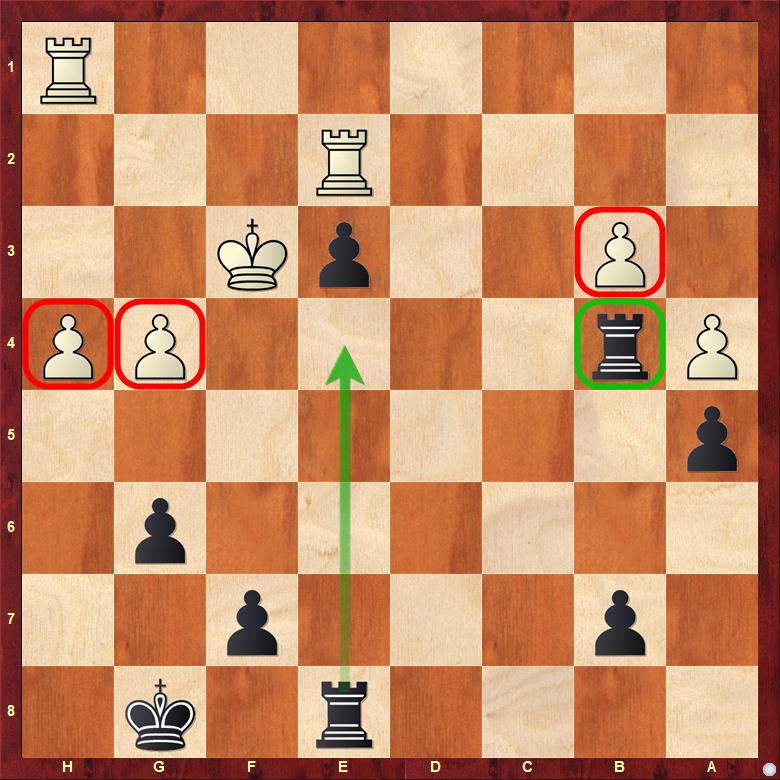
The rooks will feast on the weak pawns by doubling on the fourth rank, which eventually decided the game in my favor. A decent start to the tournament.
(2)
In my second game against a 2039-rated player with White, I got a nice advantage quickly, however things fizzled out as I didn't make the most of it.
In the following position, which should be a draw objectively, my last move 26.Rbd1 was a decent practical idea aiming to activate both rooks and create some threats against the Black kingside, particularly the f7-pawn.
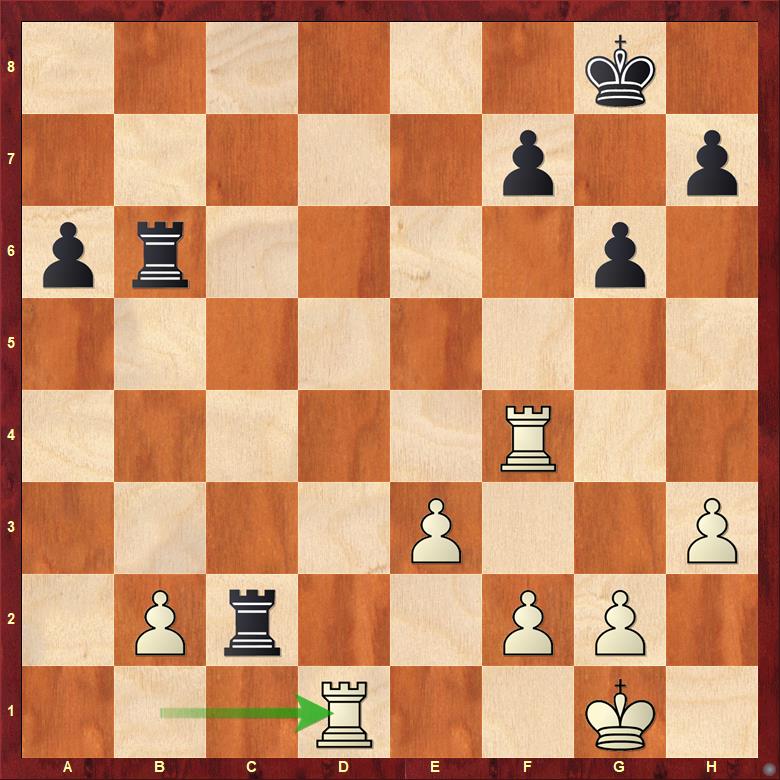
However, if Black treads carefully, he should be able to liquidate into the classic R+4 vs. R+3 rook endgame, where a draw would be the logical result. 26. ...Kg7 intending ...Rf6 to trade the active f4-rook is one way to go for that.
However, after 26. ...Rcxb2? 27.Rd7 f6 28.Rc4 (threatening checkmate) Rb8 29.Rcc7 the rooks invaded on the seventh rank and won the game soon after.
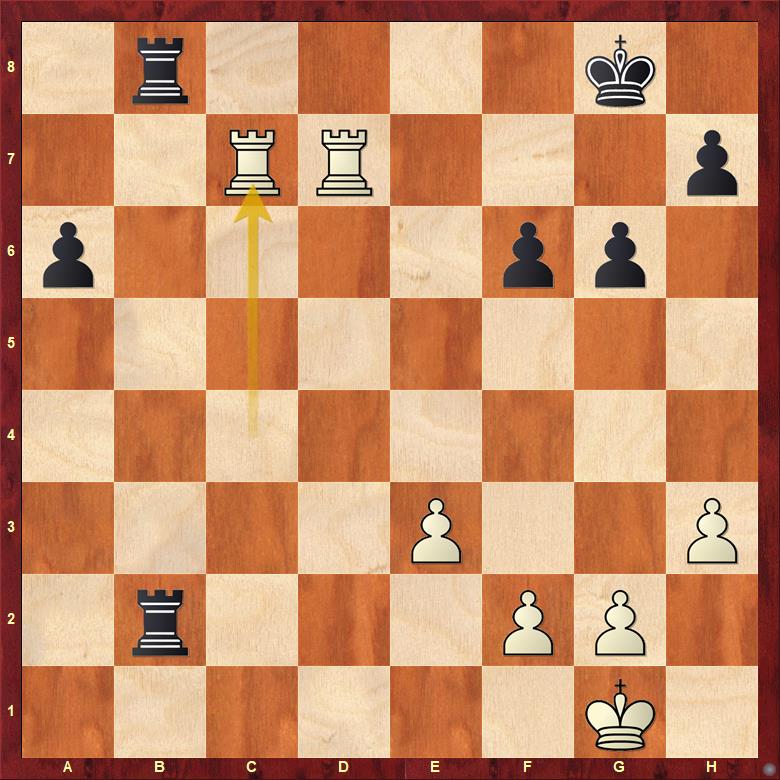
Not the cleanest game, but got the win and started the tournament well with 2/2. By the way, in both games, doubling the rooks horizontally was the winning motif, which is a noteworthy coincidence. Also shows how strong a pair of rooks can be.
(3)
In the third round, I faced FM Van Baar (2179) with the black pieces. In a complex queen-less middlegame, I slowly got the upper hand and opted for a tricky option with 33. ...Bd4!?. This apparently wasn't the best move objectively, but it did provoke the mistake 34.b3??, which was crucial for my chances in one line I calculated, as it opens the squares c3 and a3 for the Black king to enter the queenside.

Here, 34.Nf5! keeps White in the game, but instead after 34.b3 Bf2! 35.Nf5 Ke6! (important not to play 35. ...Kf6, as we need to be able to run toward the queenside as quickly as possible!) Black is indeed winning.

Black is attacking the knight and the h4-pawn, and White has no good way of dealing with the threats. The crucial point is revealed in the line that materialised in the game and that was my reason for trying ...Bd4: after 36.Ke2 (counter-attacking the f2-bishop) the ensuing pawn-endgame is winning: 36. ...Bxf5 37.Kxf2 Bxe4 38.fxe4 Kd6 39.Ke3 Kc5 40.Kd3 Kb4 41.Kc2 Ka3! (now the reason behind ...Bd4 becomes clearer) 42.Kc3 c5 43.Kc2 Ka2 44.Kc3 Kb1 and my opponent had to resign.

I am quite happy with the calculation to come up with the tricky ...Bd4 and the game as a whole was quite decent as well, even though both sides made some mistakes along the way.
(4)
For the first time in this tournament, I was paired against a higher-rated player, the legendary (and former 2700-rated) Michal Krasenkow (2534). I didn't get anything out of the opening (even though my opponent gave me a great opportunity by playing a very dubious line, which I couldn't punish though) and offered a draw on move 11, as there was absolutely nothing in my position to write home about (though I wasn't worse either).
My opponent understandibly declined without much thought, but made a positional mistake a couple moves later:

After Black's last move, 13. ...Rad8, I can transform the pawn structure in my favor by playing 14.Nxd4 exd4 15.Lg5! followed by taking on f6, when a classic opposite-color bishop struggle arises, where Black's bishop is pretty much useless and my kingside pawn mass is much more mobile than Black's queenside pawn majority. It wasn't easy to capitalise on this strategic edge though, and I was helped by one more mistake later on:

After the slightly careless move 27. ...Qc5-d6 (the more prudent ...Qe7 was needed), I was able to break open the position to my advantage with 28.e5!, after which Black's king simply becomes too vulnerable, which thankfully I was able to take advantage of and I won the game from here without too much trouble.
While the game was far from exceptional, I am of course still very happy about winning against an experienced grandmaster!
(5)
After a perfect start of 4/4, I was awarded with a game against young Belgian GM Daniel Dardha (2598).
With the black pieces, I chose a complex opening that led to a rich middlegame where my opponent was better most of the time, but not by too much. I even had a couple of chances along the way to grab the initiative, which I missed.
I was never clearly lost until I made the crucial mistake in a double rook endgame.
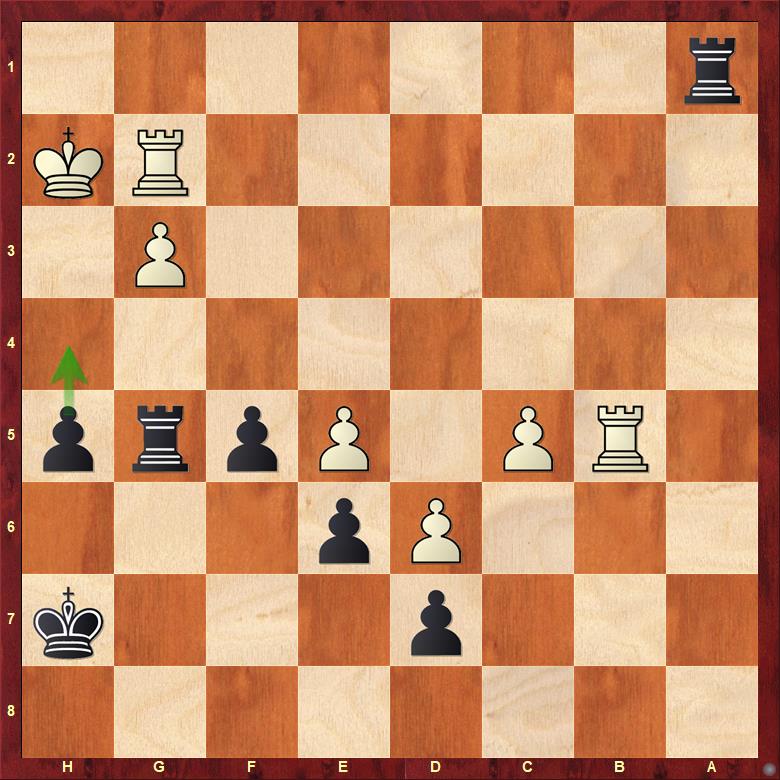
Here, I should've started counterplay immediately with 51. ...h4!, after which the position is equal. For example 52.gxh4 Rh5! 53.Rb4 Rc1!, defending against White's main idea, the c5-c6 break, and Black is holding. Instead, the slow 51. ...Rc1 allowed 52.Rb7 Rg7 53.Rc7! where White is simply winning as Black has no defence against a well-timed c5-c6 break.
Despite the loss this game gave me some confidence for future games against strong grandmasters. They clearly make mistakes and allow chances as well; one just has to be alert and take advantage of them! Hopefully I'll be better at this in the future.
(6)
Now at 4/5, I was White against Labruyére, a young 2207-rated Dutch player. I of course wanted to win to continue what had been a very good tournament so far despite the loss in the previous round.
I gained some advantage out of the opening, my opponent played ressourcefully though and also put a lot of pressure on the clock. In time trouble before the 40th move, the game fizzled out to this position:

Here, Black has to make one more move to reach time control. With 40. ...Nd6, Black reroutes the knight to greener pastures and holds the balance as it's not easy for White to make use of Black's compromised kingside pawn structure.
However, my opponent made the mistake of offering a queen trade with 40. ...Qd4, after which White can trade into a virtually winning bishop vs. knight endgame with 41.Qxd4 Nxd4 42.Be4!
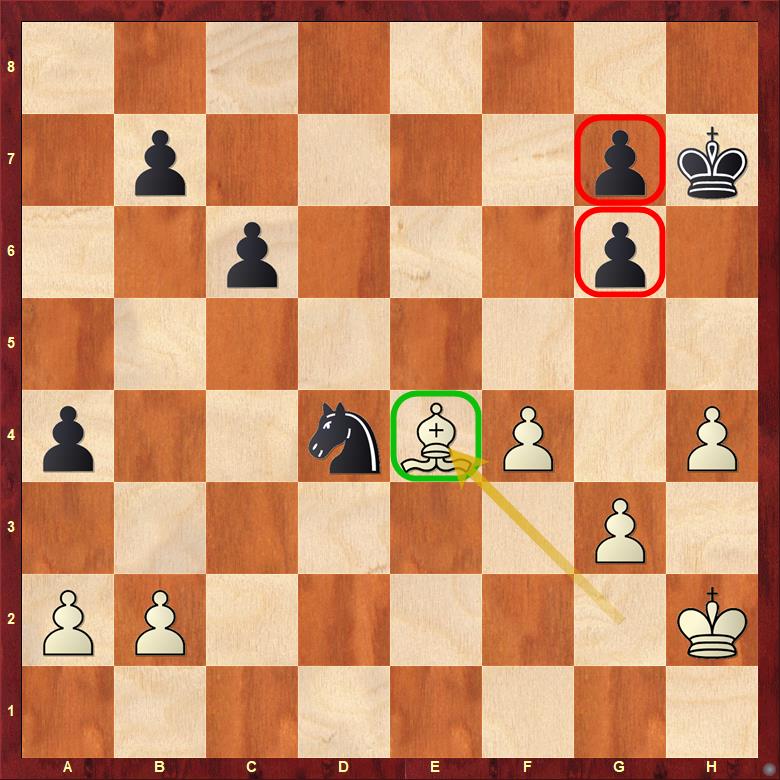
Here, Black's king was tied to defend g6, while I could slowly but surely walk my king to the queenside and overwhelm my opponents defences. A nice example of how strong a bishop can be against a knight in an endgame with pawns on both sides of the board. In this case, the bishop attacks the kingside while defending against Black's majority advancing on the queenside.
The final position was quite picturesque:

That's what I call domination! Neither Black's king nor his knight can ever make it back into the game (without the latter sacrificing itself).
White will now just queen the a-pawn. Note that ...g7-g6 is met with f5-f6! keeping the walls of the prison intact :)
(7)
I now was paired with Black against young American IM Ghazarian (2474). The game ended peacefully relatively quickly, as my opponent couldn't prove an advantage and offered a draw which I accepted as there wasn't much to play for for me either. This was the final position:
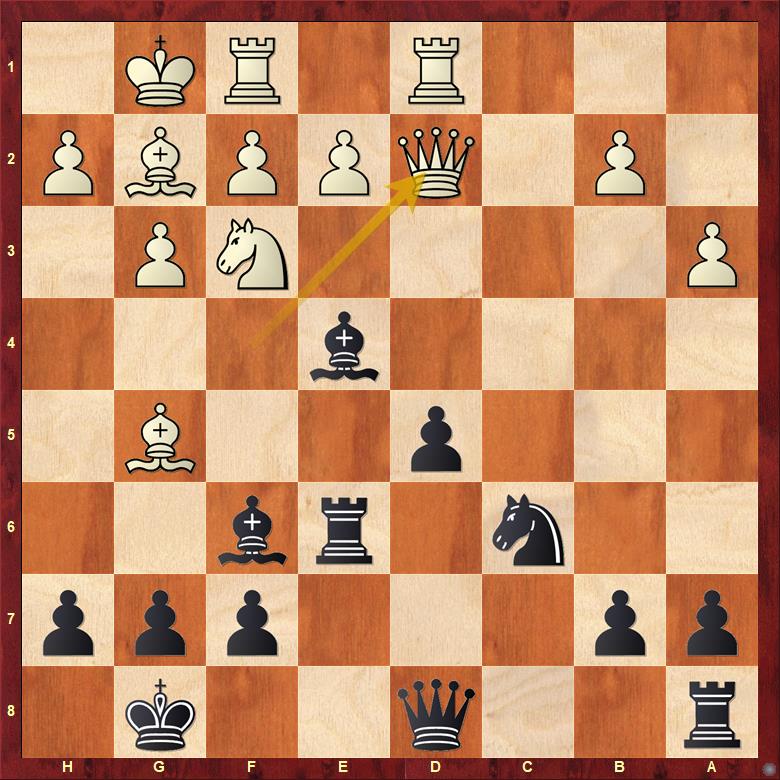
A decent result, after which I still had chances for a GM norm even.
(8)
I was now White against a strong Dutch IM Leenhouts (2446). If I were to keep chances for a GM norm alive, I pretty much had to win. I prepared extensively for this game, though my opponent surprised me by opting for a variation he had never played before. I still had some ideas in that line, so I wasn't entirely out of book, but the game flattened and I burned too much time trying to keep a small edge.

In this position, my opponent offered a draw and I accepted as I didn't see how to push for more. White is a pawn up, but that pawn is very vulnerable. The engine suggests to try and hold on to it with 16.Nc3 Bf5 17.Nd5 (which didn't even occur to me to be honest), but even there, Black seems to be fine after 17. ...Re5 18.0-0-0 Rc8!
Not an ideal result, but not a bad one either. Sadly, at this point GM norm chances were pretty much out of the window, but that's ok. After all, a rating of 2500 is the primary goal. If at some point I'll manage to play like a 2500+ consistently, eventually the norms will happen naturally.
And of course, a great tournament with a healthy rating gain was still possible.
(9)
In the last round, I was black against IM de Jong (2313). My opponent took some risks in the opening and I had great chances of pushing through with a dangerous attack.

Here, I should have pushed the centralised white knight out and continued my development afterwards by playing 13. ...f6 14.Nef3 Ne6, where Black has more than just compensation for the sacrificed pawn.
I did consider ...f7-f6, but thought it would weaken the light squares too much in the long term, so I instead took the exchange and played 13. ...Bxf1 14.Nxf1 Nf6. Black is still slightly better objectively, but the position is very difficult to play I found, as White has some excellent practical compensation.
From here, I played bad moves too slowly (never good combining bad and slow) and reached this position:

With my last move, 19. ...Rc8, I offered a draw, as I realised that the position had turned against me, and my opponent accepted the offer.
If there is one positive thing about this last game, it's that I realised that the ship had sailed and managed to make the right practical decision of offering a draw before things got even worse.
I wasn't sure about the evaluation, but I was very unhappy with my position, and in fact, engine says roughly +1 with moves like 20.Ba3 intending Rc1, simply building up the pressure.
Summary and what's next
All in all a good tournament, although I would've liked to make more out of my last two games.
I noticed that I still need to improve on my opening as I spent too much time preparing before the games. I've mentioned this before, but the ideal scenario would be to have the lines ready and mostly memorised so that before during the tournament the only thing left to do is to choose the opening and briefly brush up on the lines.
Apart from that, I'm happy with the general quality of my games, although I need to be better at sensing the moment were it's possible to turn the game around and build a sudden initiative.
Also, my time-management was far from ideal, I need to play faster and take practical decisions more often instead of trying to control everything, which burns a lot of clock.
This tournament takes me to a live rating of 2436, which is a clear personal best, but there is more chess to play this month.
Also, apart from the chess itself, it's always a great time traveling to tournaments with good friends. The weather was pretty awful the first couple of days, but the sun came out toward the end of the week, and we even went for a quick swim in the sea.
I should also note that my good friend and part of our little travel group, FM Vöge --https://lichess.org/@/Unkreativ3 -- managed to beat GM Loek van Wely with the black pieces! Here's the game: https://chess24.com/de/watch/live-tournaments/hogeschool-zeeland-2023/3/1/1
(The 27th + the 30th move were perhaps the highlight of that game!)
So what's next?
Today, the Iuliu Szabo GM tournament in Satu Mare, Romania, has started:
https://chess-results.com/tnr783145.aspx?lan=1
I'm finishing up this post after having played my first game there: a draw with Black against GM Okhotnik.
Later this month, I'll be playing a 7-round-open back in Germany:
http://schlosspark-open.de/?q=node/727
Then, in September, I'll be playing in Triest: https://vesus.org/tournament/EqBtGRoB?selectedTab=tournament.participants
All in all it's a pretty intense few weeks of chess and I hope to make the most of it. 35 games in just over a month:
- 05. - 12.08. Vlissingen (9 rounds)
- 14. - 20.08. Satu Mare (9 rounds)
- 24. - 27.08. Wiesbaden (7 rounds)
- 02. - 08.09. Trieste (9 rounds)
I'll be back continuing the blog with a recap for the tournament that has just started.
Thanks so much for reading and for following along :) Have a great week!
Cheers.
More blog posts by iakov98

Challenge 2500 | Almost halfway there!
After Vlissingen, I competed in two more tournaments in August. In this brief article I summarise th…
Challenge 2500 | 10. Training Continues
In this post, I'll recap how this project has been going so far, set some goals and intentions for t…
How do you visualise chess positions?
I'm exploring the topic of how chess players visualise positions and would like to write a post abou…